Ameliorative Effect of Ethanolic Extract of Moringa oleifera Leaves in Combination with Curcumin against PTZ-Induced Kindled Epilepsy in Rats: In Vivo and In Silico
Abstract
:1. Introduction
2. Results
2.1. Effect of MOEE and Curcumin on the Seizure Severity Score in Pentyletetrazole Treated Rats
2.2. Neurobehavioral Observations
2.2.1. Effects of MOEE and Curcumin on Elevated Plus Maze Apparatus
2.2.2. Effects of MOEE and Curcumin on Passive Avoidance Test
2.2.3. Effect of MOEE and Curcumin in Open Field Apparatus
2.3. In-Vivo Antioxidant Activity
2.3.1. Effects of MOEE and Curcumin on Brain MDA Level
2.3.2. Effects of MOEE and Curcumin on Brain of Glutathione Level
2.3.3. Effect of MOEE and Curcumin on Brain of SOD Levels
2.3.4. Effect of MOEE and Curcumin on Brain Catalase Levels
2.3.5. Effects of MOEE and Curcumin on Brain of NO Levels
2.3.6. Effects of MOEE and Curcumin in Brain of AchE Levels
2.4. Binding Mode Analysis of Curcumin, Quercetin, Chlorogenic Acid and Valproic Acid
2.4.1. Post-Docking Analysis
2.4.2. Binding Mode Analysis
3. Discussion
4. Materials and Methods
4.1. Reagents and Chemicals
4.2. Preparation of M. oleifera Leaves Extract
4.3. Inducing of Kindled Seizures and Experiment Design
4.3.1. Neurobehavioral Assessment
4.3.2. Elevated Plus Maze Test
4.3.3. Step-Through Passive Avoidance Test
4.3.4. Open Field Test (OFT)
4.4. Measurement of Oxidative Stress
4.4.1. Lipid Peroxidation (MDA)
4.4.2. Reduced Glutathione Estimation
4.4.3. Superoxide Dismutase Estimation
4.4.4. Catalase Estimation
4.4.5. Nitrite Estimation
4.4.6. Acetyl Cholinesterase Activity
4.5. In Silco Docking Analysis of Curcumin, Quercitin and Chlorogenic Acid in Compare with Valproic Acid as Anti-Epileptic Drug
4.6. Statistical Analysis
5. Conclusions
Author Contributions
Funding
Institutional Review Board Statement
Informed Consent Statement
Data Availability Statement
Acknowledgments
Conflicts of Interest
References
- Huang, W.; Manglik, A.; Venkatakrishnan, A.J.; Laeremans, T.; Feinberg, E.N.; Sanborn, A.L.; Kato, H.E.; Livingston, K.E.; Thorsen, T.S.; Kling, R.C.; et al. Structural insights into µ-opioid receptor activation. Nature 2015, 524, 315–321. [Google Scholar] [CrossRef]
- Mishchenko, M.; Shtrygol, S.; Lozynskyi, A.; Hoidyk, M.; Khyluk, D.; Gorbach, T.; Lesyk, R. Evaluation of 5-[(Z)-(4-nitrobenzylidene)]-2-(thiazol-2-ylimino)-4-thiazolidinone (Les-6222) as Potential Anticonvulsant Agent. Sci. Pharm. 2022, 90, 56. [Google Scholar] [CrossRef]
- Borowicz-Reutt, K.K.; Czuczwar, S.J. Role of oxidative stress in epileptogenesis and potential implications for therapy. Pharmacol. Rep. 2020, 72, 1218–1226. [Google Scholar] [CrossRef]
- Aboutabl, M.E. Antiepileptic drugs: Progress and development. Egypt. Pharm. J. 2018, 17, 129. [Google Scholar]
- Abraham, S.; Shaju, M. Innovations in epilepsy management—An overview. J. Pharm. Pharm. Sci. 2013, 16, 564–576. [Google Scholar] [CrossRef]
- Fujisawa, S.; Atsumi, T.; Ishihara, M.; Kadoma, Y. Cytotoxicity, ROS-generation activity and radical-scavenging activity of curcumin and related compounds. Anticancer Res. 2004, 24, 563–570. [Google Scholar]
- Melekh, B.; Ilkiv, I.; Lozynskyi, A.; Sklyarov, A. Antioxidant enzyme activity and lipid peroxidation in rat liver exposed to celecoxib and lansoprazole under epinephrine-induced stress. J. Appl. Pharm. Sci. 2017, 7, 94–99. [Google Scholar]
- Fattorusso, A.; Matricardi, S.; Mencaroni, E.; Dell’Isola, G.B.; Di Cara, G.; Striano, P.; Verrotti, A. The pharmacoresistant epilepsy: An overview on existant and new emerging therapies. Front. Neurol. 2021, 12, 674483. [Google Scholar] [CrossRef]
- Romm, E.L.; Tsigelny, I.F. Artificial Intelligence in Drug Treatment. Ann. Rev. Pharmacol. Toxicol. 2020, 6, 353–369. [Google Scholar] [CrossRef]
- Aggarwal, B.B.; Sung, B. Pharmacological basis for the role of curcumin in chronic diseases: An age-old spice with modern targets. Trends Pharmacol. Sci. 2009, 30, 85–94. [Google Scholar] [CrossRef]
- Patel, M.N. Oxidative stress, mitochondrial dysfunction, and epilepsy. Free. Radic. Res. 2002, 36, 1139–1146. [Google Scholar] [CrossRef] [PubMed]
- Cavazos, J.E.; Das, I.; Sutula, T.P. Neuronal loss induced in limbic pathways by kindling: Evidence for induction of hippocampal sclerosis by repeated brief seizures. J. Neurosci. 1994, 14, 3106–3121. [Google Scholar] [CrossRef] [PubMed]
- Koshal, P.; Kumar, P. Neurochemical modulation involved in the beneficial effect of liraglutide, GLP-1 agonist on PTZ kindling epilepsy-induced comorbidities in mice. Mol. Cell. Biochem. 2016, 415, 77–87. [Google Scholar] [CrossRef]
- Ahmed, S.R.; Rabbee, M.F.; Roy, A.; Chowdhury, R.; Banik, A.; Kubra, K.; Baek, K.H. Therapeutic promises of medicinal plants in Bangladesh and their bioactive compounds against ulcers and inflammatory diseases. Plants 2021, 10, 1348. [Google Scholar] [CrossRef]
- Angelova, P.R. Sources and triggers of oxidative damage in neurodegeneration. Free Radic. Biol. Med. 2021, 173, 52–63. [Google Scholar] [CrossRef]
- Kou, X.; Li, B.; Olayanju, J.B.; Drake, J.M.; Chen, N. Nutraceutical or pharmacological potential of Moringa oleifera Lam. Nutrients 2018, 10, 343. [Google Scholar] [CrossRef]
- Alam, M.N.; Kaushik, R.; Singh, L.; Khan, N.A. Quantitative estimation of polyphenolic biomarker quercetin and chlorogenic acid in moringa oleifera leaves by hyphenated high-performance thin-layer chromatography (HPTLC) techniques. Int. J. Drug Del. Tech. 2021, 11, 1123–1129. [Google Scholar]
- Sharma, R.A.; Gescher, A.J.; Steward, W.P. Curcumin: The story so far. Eur. J. Cancer 2005, 41, 1955–1968. [Google Scholar] [CrossRef] [PubMed]
- Gupta, S.C.; Patchva, S.; Aggarwal, B.B. Therapeutic roles of curcumin: Lessons learned from clinical trials. AAPS J. 2013, 15, 195–218. [Google Scholar] [CrossRef] [PubMed]
- Mukherjee, S.; Mishra, A.K.; Peer, G.G.; Bagabir, S.A.; Haque, S.; Pandey, R.P.; Raj, V.S.; Jain, N.; Pandey, A.; Kar, S.K. The interplay of the unfolded protein response in neurodegenerative diseases: A therapeutic role of curcumin. Front. Aging Neurosci. 2021, 13, 767493. [Google Scholar] [CrossRef] [PubMed]
- Park, J.H.; Lee, B.M.; Kim, H.S. Potential protective roles of curcumin against cadmium-induced toxicity and oxidative stress. J. Toxicol. Environ. Health 2021, 24, 95–118. [Google Scholar] [CrossRef]
- Cetin, A.; Bursal, E.; Türkan, F. 2-methylindole analogs as cholinesterases and glutathione S-transferase inhibitors: Synthesis, biological evaluation, molecular docking, and pharmacokinetic studies. Arab. J. Chem. 2021, 14, 103449. [Google Scholar] [CrossRef]
- Löscher, W.; Schmidt, D. Modern antiepileptic drug development has failed to deliver: Ways out of the current dilemma. Epilepsia 2011, 52, 657–678. [Google Scholar] [CrossRef]
- Franco, V.; French, J.A.; Perucca, E. Challenges in the clinical development of new antiepileptic drugs. Pharmacol. Res. 2016, 103, 95–104. [Google Scholar] [CrossRef] [PubMed]
- Corda, M.G.; Giorgi, O.; Longoni, B.; Orlandi, M.; Biggio, G. Decrease in the function of the γ-aminobutyric acid-coupled chloride channel produced by the repeated administration of pentylenetetrazol to rats. J. Neurochem. 1990, 55, 1216–1221. [Google Scholar] [CrossRef]
- Kumar, G.P.; Khanum, F. Neuroprotective potential of phytochemicals. Pharmacogn. Rev. 2012, 6, 81. [Google Scholar] [CrossRef] [PubMed]
- Guekht, A.; Brodie, M.; Secco, M.; Li, S.; Volkers, N.; Wiebe, S. The road to a World Health Organization global action plan on epilepsy and other neurological disorders. Epilepsia 2021, 62, 1057–1063. [Google Scholar] [CrossRef]
- Bruce, A.J.; Baudry, M. Oxygen free radicals in rat limbic structures after kainate-induced seizures. Free Radic. Biol. Med. 1995, 18, 993–1002. [Google Scholar] [CrossRef]
- Palop, J.J.; Mucke, L. Network abnormalities and interneuron dysfunction in Alzheimer disease. Nat. Rev. Neurosci. 2016, 17, 777–792. [Google Scholar] [CrossRef]
- Fisher, R.S.; Boas, W.V.E.; Blume, W.; Elger, C.; Genton, P.; Lee, P.; Engel, J., Jr. Epileptic seizures and epilepsy: Definitions proposed by the International League Against Epilepsy (ILAE) and the International Bureau for Epilepsy (IBE). Epilepsia 2005, 46, 470–472. [Google Scholar] [CrossRef]
- Geronzi, U.; Lotti, F.; Grosso, S. Oxidative stress in epilepsy. Exp. Rev. Neurother. 2018, 18, 427–434. [Google Scholar] [CrossRef]
- Löscher, W.; Klitgaard, H.; Twyman, R.E.; Schmidt, D. New avenues for anti-epileptic drug discovery and development. Nat. Rev. Drug Discov. 2013, 12, 757–776. [Google Scholar] [CrossRef]
- Park, K.M.; Kim, S.E.; Lee, B.I. Antiepileptic drug therapy in patients with drug-resistant epilepsy. J. Epilepsy Res. 2019, 9, 14. [Google Scholar] [CrossRef]
- Alhakmani, F.; Kumar, S.; Khan, S.A. Estimation of total phenolic content, in–vitro antioxidant and anti–inflammatory activity of flowers of Moringa oleifera. Asian Pac. J. Trop. Biomed. 2013, 3, 623–627. [Google Scholar] [CrossRef]
- Mousa, A.A.; El-Gansh, H.A.I.; Eldaim, M.A.A.; Mohamed, M.A.E.G.; Morsi, A.H.; El Sabagh, H.S. Protective effect of Moringa oleifera leaves ethanolic extract against thioacetamide-induced hepatotoxicity in rats via modulation of cellular antioxidant, apoptotic and inflammatory markers. Environ. Sci. Pollut. Res. 2019, 26, 32488–32504. [Google Scholar] [CrossRef]
- Bakre, A.G.; Aderibigbe, A.O.; Ademowo, O.G. Studies on neuropharmacological profile of ethanol extract of Moringa oleifera leaves in mice. J. Ethnopharmacol. 2013, 149, 783–789. [Google Scholar] [CrossRef] [PubMed]
- Fantoukh, O.I.; Albadry, M.A.; Parveen, A.; Hawwal, M.F.; Majrashi, T.; Ali, Z.; Khan, S.I.; Chittiboyina, A.G.; Khan, I.A. Isolation, synthesis, and drug interaction potential of secondary metabolites derived from the leaves of miracle tree (Moringa oleifera) against CYP3A4 and CYP2D6 isozymes. Phytomedicine 2019, 60, 153010. [Google Scholar] [CrossRef] [PubMed]
- Ghimire, S.; Subedi, L.; Acharya, N.; Gaire, B.P. Moringa oleifera: A tree of life as a promising medicinal plant for neurodegenerative diseases. J. Agric. Food Chem. 2021, 69, 14358–14371. [Google Scholar] [CrossRef] [PubMed]
- Mansouri, K.; Rasoulpoor, S.; Daneshkhah, A.; Abolfathi, S.; Salari, N.; Mohammadi, M.; Rasoulpoor, S.; Shabani, S. Clinical effects of curcumin in enhancing cancer therapy: A systematic review. BMC Cancer 2020, 20, 791. [Google Scholar] [CrossRef]
- Aggarwal, B.B.; Harikumar, K.B. Potential therapeutic affects of curcumin, the anti-inflammatory agent, against neurodegenerative, cardiovascular, pulmonary, metabolic, autoimmune and neoplastic diseases. Int. J. Biochem. Cell Biol. 2009, 41, 40–59. [Google Scholar] [CrossRef]
- Karthikeyan, A.; Young, K.N.; Moniruzzaman, M.; Beyene, A.M.; Do, K.; Kalaiselvi, S.; Min, T. Curcumin and its modified formulations on inflammatory bowel disease (IBD): The story so far and future outlook. Pharmaceutics 2021, 13, 484. [Google Scholar] [CrossRef]
- Sachett, A.; Gallas-Lopes, M.; Benvenutti, R.; Marcon, M.; Aguiar, G.P.S.; Herrmann, A.P.; Oliveira, J.V.; Siebel, A.M.; Piato, A. Curcumin micronization by supercritical fluid: In vitro and in vivo biological relevance. Ind. Crops Prod. 2022, 177, 114501. [Google Scholar] [CrossRef]
- Chanioti, S.; Katsouli, M.; Tzia, C. Novel processes for the extraction of phenolic compounds from olive pomace and their protection by encapsulation. Molecules 2021, 26, 1781. [Google Scholar] [CrossRef]
- Zhang, B.; Zhang, J.W.; Wang, W.P.; Dong, R.F.; Tian, S.; Zhang, C. Effect of lamotrigine on epilepsy-induced cognitive impairment and hippocampal neuronal apoptosis in pentylenetetrazole-kindled animal model. Synapse 2017, 71, e21945. [Google Scholar] [CrossRef] [PubMed]
- Mehla, J.; Reeta, K.H.; Gupta, P.; Gupta, Y.K. Protective effect of curcumin against seizures and cognitive impairment in a pentylenetetrazole-kindled epileptic rat model. Life Sci. 2010, 87, 596–603. [Google Scholar] [CrossRef] [PubMed]
- Morimoto, K.; Fahnestock, M.; Racine, R.J. Kindling and status epilepticus models of epilepsy: Rewiring the brain. Prog. Neurobiol. 2004, 73, 1–60. [Google Scholar] [CrossRef]
- Racine, R.J. Modification of seizure activity by electrical stimulation: II. Motor seizure. Electroencephal. Clin. Neurophysiol. 1972, 32, 281–294. [Google Scholar] [CrossRef]
- Sarangi, S.C.; Joshi, D.; Kumar, R.; Kaleekal, T.; Gupta, Y.K. Pharmacokinetic and pharmacodynamic interaction of hydroalcoholic extract of Ocimum sanctum with valproate. Epilepsy Behav. 2017, 75, 203–209. [Google Scholar] [CrossRef]
- Moavero, R.; Santarone, M.E.; Galasso, C.; Curatolo, P. Cognitive and behavioral effects of new antiepileptic drugs in pediatric epilepsy. Brain Dev. 2017, 39, 464–469. [Google Scholar] [CrossRef]
- Rauramaa, T.; Pikkarainen, M.; Englund, E.; Ince, P.G.; Jellinger, K.; Paetau, A.; Alafuzoff, I. Consensus recommendations on pathologic changes in the hippocampus: A postmortem multicenter inter-rater study. J. Neuropathol. Exp. Neurol. 2013, 72, 452–461. [Google Scholar] [CrossRef] [PubMed]
- Farrell, J.S.; Wolff, M.D.; Teskey, G.C. Neurodegeneration and Pathology in Epilepsy: Clinical and Basic Perspectives. Adv. Neurobiol. 2017, 15, 317–334. [Google Scholar]
- Bayrak, B.B.; Yilmaz, S.; Hacihasanoglu Cakmak, N.; Yanardag, R. The effects of edaravone, a free-radical scavenger in lung injury induced by valproic acid demonstrated via different biochemical parameters. J. Biochem. Mol. Toxicol. 2021, 35, e22847. [Google Scholar] [CrossRef]
- Samokhina, E.; Samokhin, A. Neuropathological profile of the pentylenetetrazol (PTZ) kindling model. Int. J. Neurosci. 2018, 128, 1086–1096. [Google Scholar] [CrossRef] [PubMed]
- Mehta, M.R.; Dasgupta, C.; Ullal, G.R. A neural network model for kindling of focal epilepsy: Basic mechanism. Biol. Cybern. 1993, 68, 335–340. [Google Scholar] [CrossRef] [PubMed]
- Uttara, B.; Singh, A.V.; Zamboni, P.; Mahajan, R. Oxidative stress and neurodegenerative diseases: A review of upstream and downstream antioxidant therapeutic options. Curr. Neuropharmacol. 2009, 7, 65–74. [Google Scholar] [CrossRef] [PubMed]
- Floyd, R.A.; Carney, J.M. Free radical damage to protein and DNA: Mechanisms involved and relevant observations on brain undergoing oxidative stress. Ann. Neurol. Off. J. Am. Neurol. Assoc. Child Neurol. Soc. 1992, 32, S22–S27. [Google Scholar] [CrossRef] [PubMed]
- Lobo, V.; Patil, A.; Phatak, A.; Chandra, N. Free radicals, antioxidants and functional foods: Impact on human health. Pharmacg. Rev. 2010, 4, 118. [Google Scholar] [CrossRef] [PubMed]
- Lovell, M.A.; Ehmann, W.D.; Butler, S.M.; Markesbery, W.R. Elevated thiobarbituric acid-reactive substances and antioxidant enzyme activity in the brain in Alzheimer’s disease. Neurology 1995, 45, 1594–1601. [Google Scholar] [CrossRef] [PubMed]
- Alachkar, A.; Ojha, S.K.; Sadeq, A.; Adem, A.; Frank, A.; Stark, H.; Sadek, B. Experimental models for the discovery of novel anticonvulsant drugs: Focus on pentylenetetrazole-induced seizures and associated memory deficits. Curr. Pharm. Des. 2020, 26, 1693–1711. [Google Scholar] [CrossRef]
- Awodele, O.; Oreagba, I.A.; Odoma, S.; da Silva, J.A.T.; Osunkalu, V.O. Toxicological evaluation of the aqueous leaf extract of Moringa oleifera Lam.(Moringaceae). J. Ethnopharmacol. 2012, 139, 330–336. [Google Scholar] [CrossRef] [PubMed]
- Bhardwaj, M.; Kumar, A. Neuroprotective effect of lycopene against PTZ-induced kindling seizures in mice: Possible behavioral, biochemical and mitochondrial dysfunction. Phytoth. Res. 2016, 30, 306–313. [Google Scholar] [CrossRef]
- File, S.E. The interplay of learning and anxiety in the elevated plus-maze. Behav. Brain Res. 1993, 58, 199–202. [Google Scholar] [CrossRef] [PubMed]
- Sharma, A.C.; Kulkarni, S.K. Evaluation of learning and memory mechanisms employing elevated plus-maze in rats and mice. Prog. Neuro-Psychopharmacol. Biol. Psychiatry 1992, 16, 117–125. [Google Scholar] [CrossRef]
- Reeta, K.H.; Mehla, J.; Gupta, Y.K. Curcumin is protective against phenytoin-induced cognitive impairment and oxidative stress in rats. Brain Res. 2009, 1301, 52–60. [Google Scholar] [CrossRef] [PubMed]
- Russell, P.A.; Williams, D.I. Effects of repeated testing on rats’ locomotor activity in the open-field. Animal Beh. 1973, 21, 109–111. [Google Scholar] [CrossRef] [PubMed]
- Ohkawa, H.; Ohishi, N.; Yagi, K. Assay for lipid peroxides in animal tissues by thiobarbituric acid reaction. Anal. Biochem. 1979, 95, 351–358. [Google Scholar] [CrossRef]
- Ellman, G.L. Tissue sulfhydryl groups. Arch. Biochem. Biophys. 1959, 82, 70–77. [Google Scholar] [CrossRef] [PubMed]
- Kono, Y. Generation of superoxide radical during autoxidation of hydroxylamine and an assay for superoxide dismutase. Arch. Biochem. Biophys. 1978, 186, 189–195. [Google Scholar] [CrossRef]
- Aebi, H. Catalase in vitro. In Methods in Enzymology; Academic Press: Cambridge, MA, USA, 1984; Volume 105, pp. 121–126. [Google Scholar] [CrossRef]
- Green, L.C.; Wagner, D.A.; Glogowski, J.; Skipper, P.L.; Wishnok, J.S.; Tannenbaum, S.R. Analysis of nitrate, nitrite, and [15N] nitrate in biological fluids. Anal. Biochem. 1982, 126, 131–138. [Google Scholar] [CrossRef]
- Gorun, V.; Proinov, I.; Băltescu, V.; Balaban, G.; Bârzu, O. Modified Ellman procedure for assay of cholinesterases in crude enzymatic preparations. Anal. Biochem. 1978, 86, 324–326. [Google Scholar] [CrossRef]
- Berkholz, D.S.; Faber, H.R.; Savvides, S.N.; Karplus, P.A. Catalytic cycle of human glutathione reductase near 1 Å resolution. J. Mol. Biol. 2008, 382, 371–384. [Google Scholar] [CrossRef] [PubMed]
- Berman, H.M.; Westbrook, J.; Feng, Z.; Gilliland, G.; Bhat, T.N.; Weissig, H.; Shindyalov, I.N.; Bourne, P.E. The protein data bank. Nucleic Acids Res. 2000, 28, 235–242. [Google Scholar] [CrossRef]
- Huey, R.; Morris, G.M.; Olson, A.J.; Goodsell, D.S. A semiempirical free energy force field with charge-based desolvation. J. Comput. Chem. 2007, 28, 1145–1152. [Google Scholar] [CrossRef]
- Güller, P.; Karaman, M.; Güller, U.; Aksoy, M.; Küfrevioğlu, Ö.İ. A study on the effects of inhibition mechanism of curcumin, quercetin, and resveratrol on human glutathione reductase through in vitro and in silico approaches. J. Biomol. Struct. Dyn. 2021, 39, 1744–1753. [Google Scholar] [CrossRef]
- Morris, G.M.; Goodsell, D.S.; Halliday, R.S.; Huey, R.; Hart, W.E.; Belew, R.K.; Olson, A.J. Automated docking using a Lamarckian genetic algorithm and an empirical binding free energy function. J. Comput. Chem. 1998, 19, 1639–1662. [Google Scholar] [CrossRef]
- Hanwell, M.D.; Curtis, D.E.; Lonie, D.C.; Vandermeersch, T.; Zurek, E.; Hutchison, G.R. Avogadro: An advanced semantic chemical editor, visualization, and analysis platform. J. Cheminform. 2012, 4, 17. [Google Scholar] [CrossRef] [PubMed]

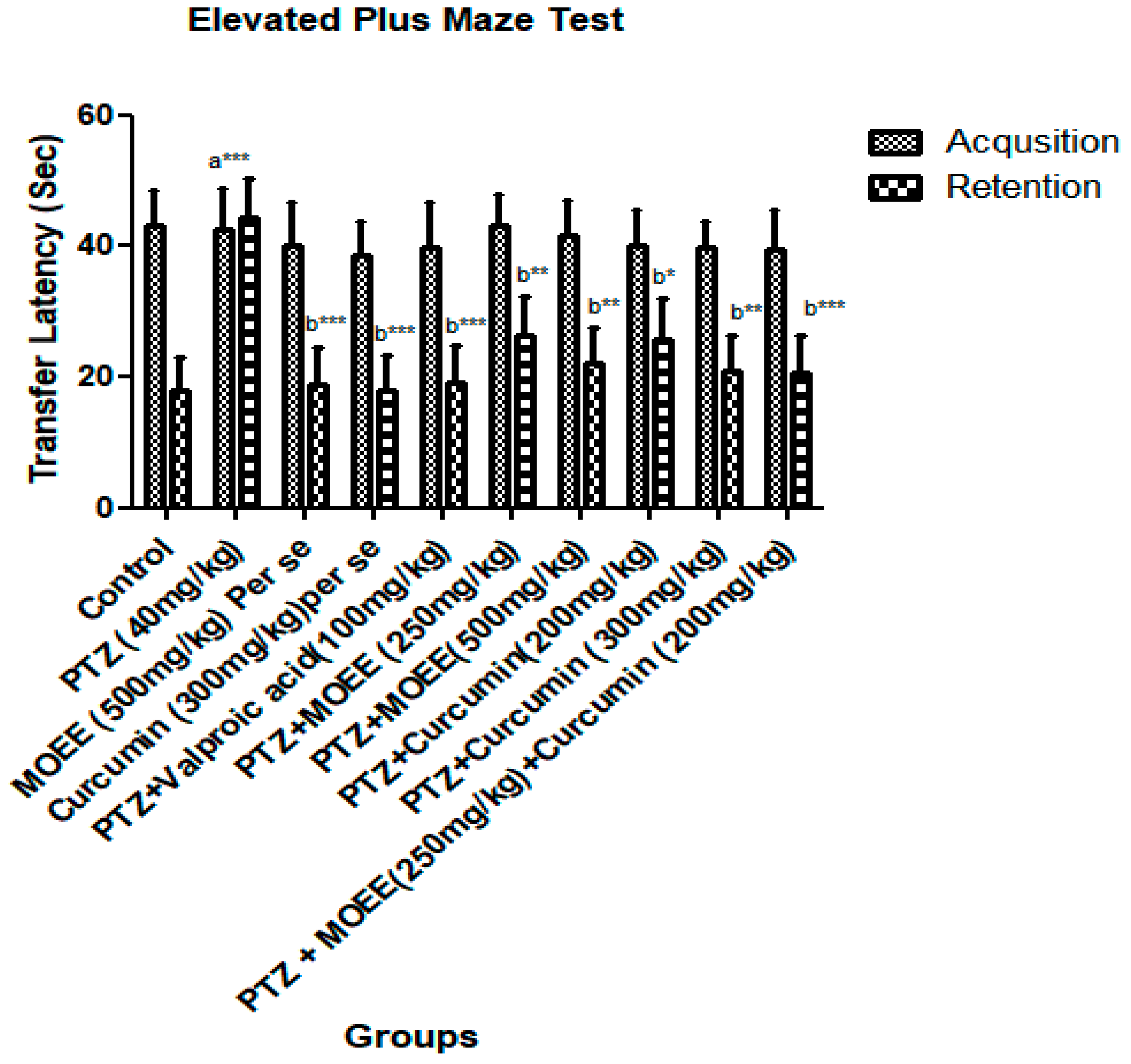
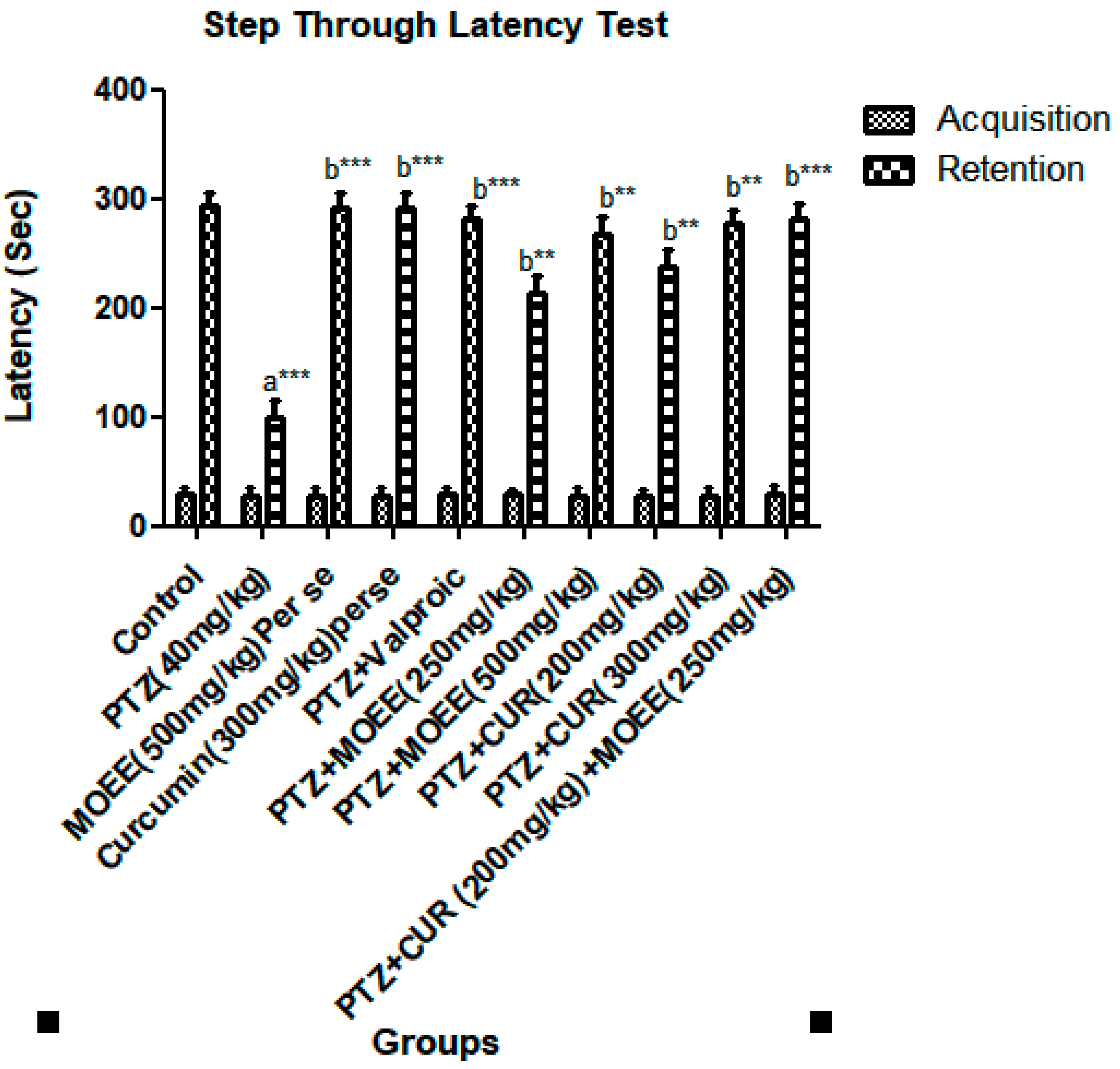
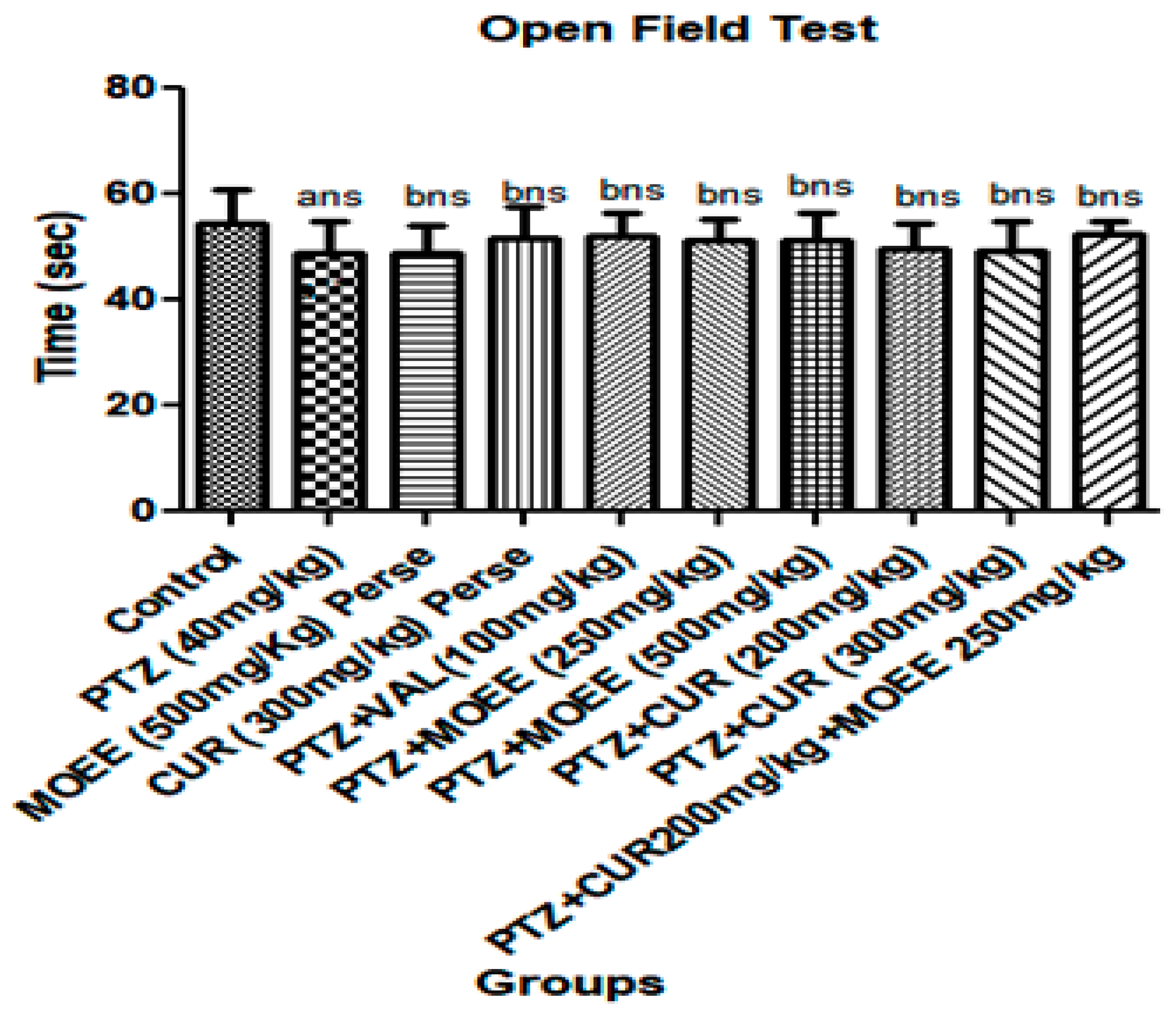
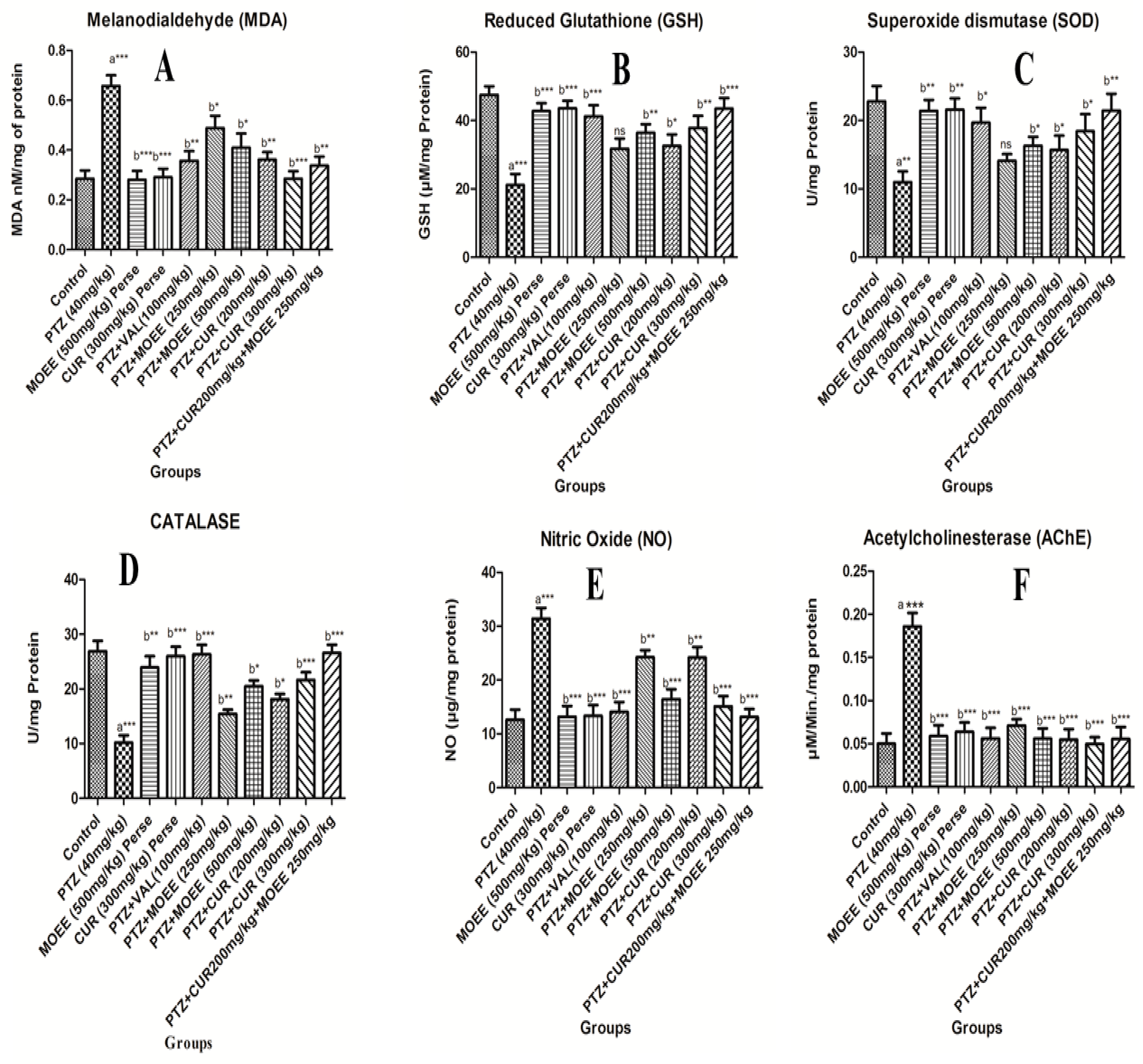
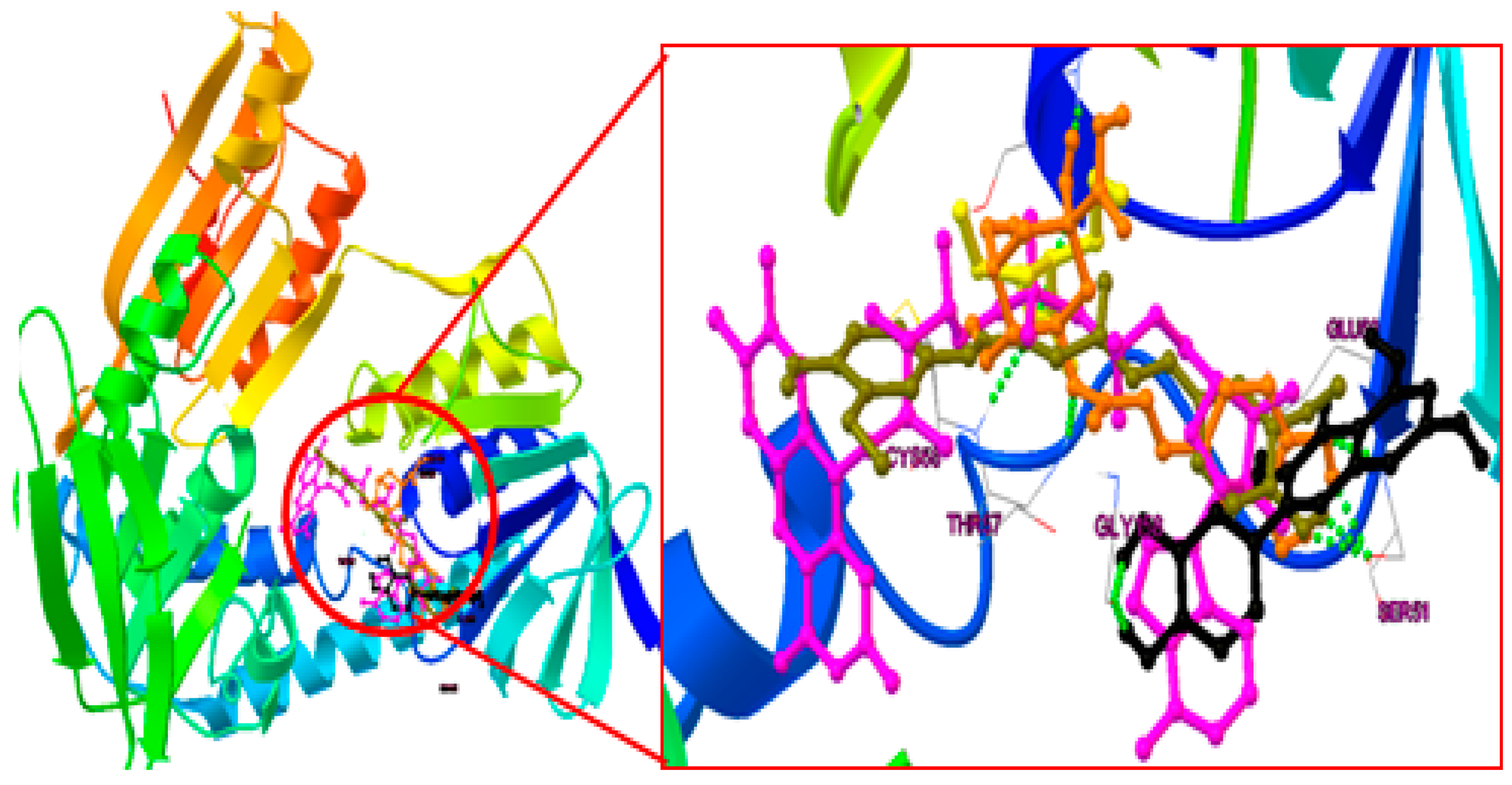
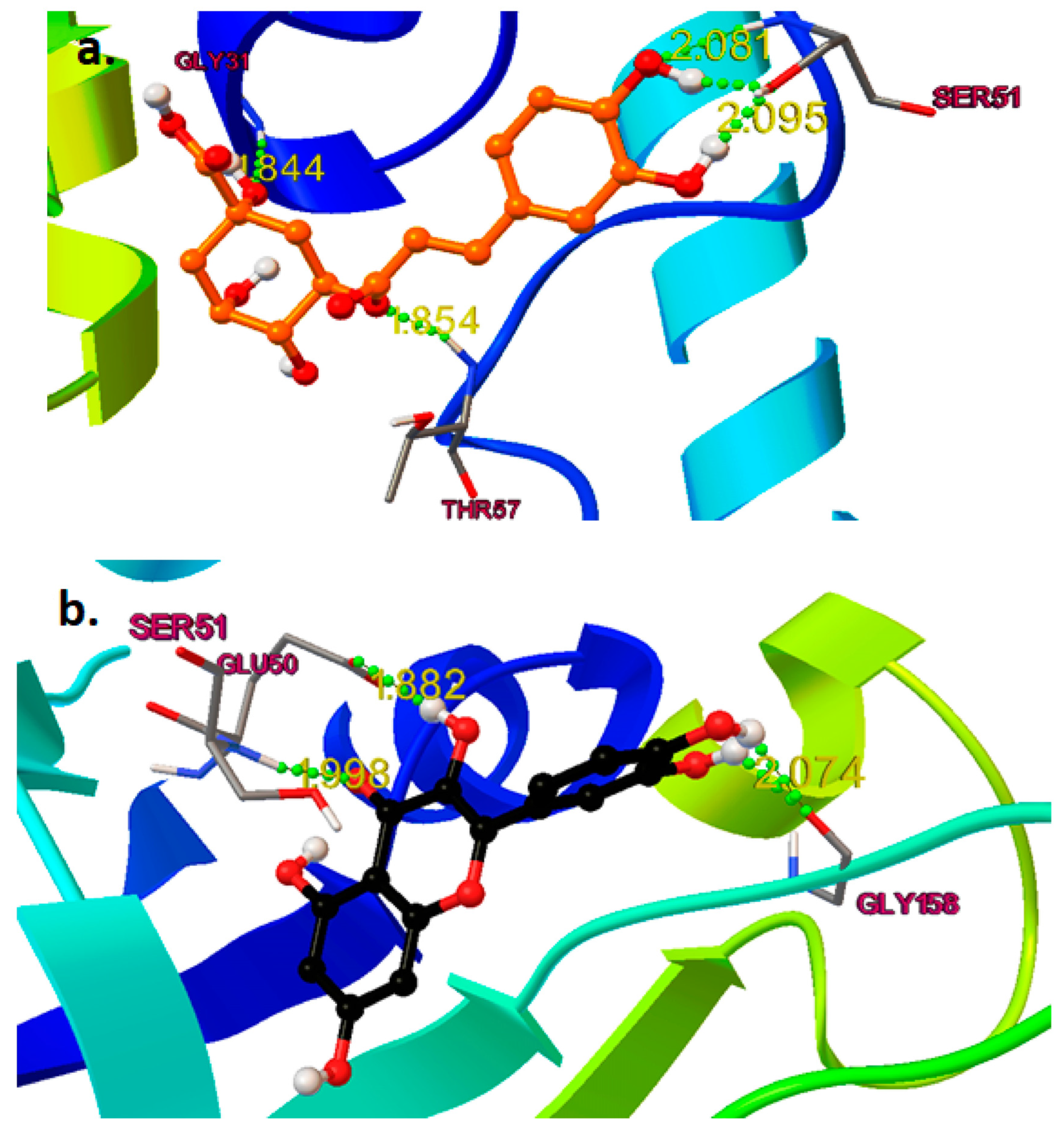
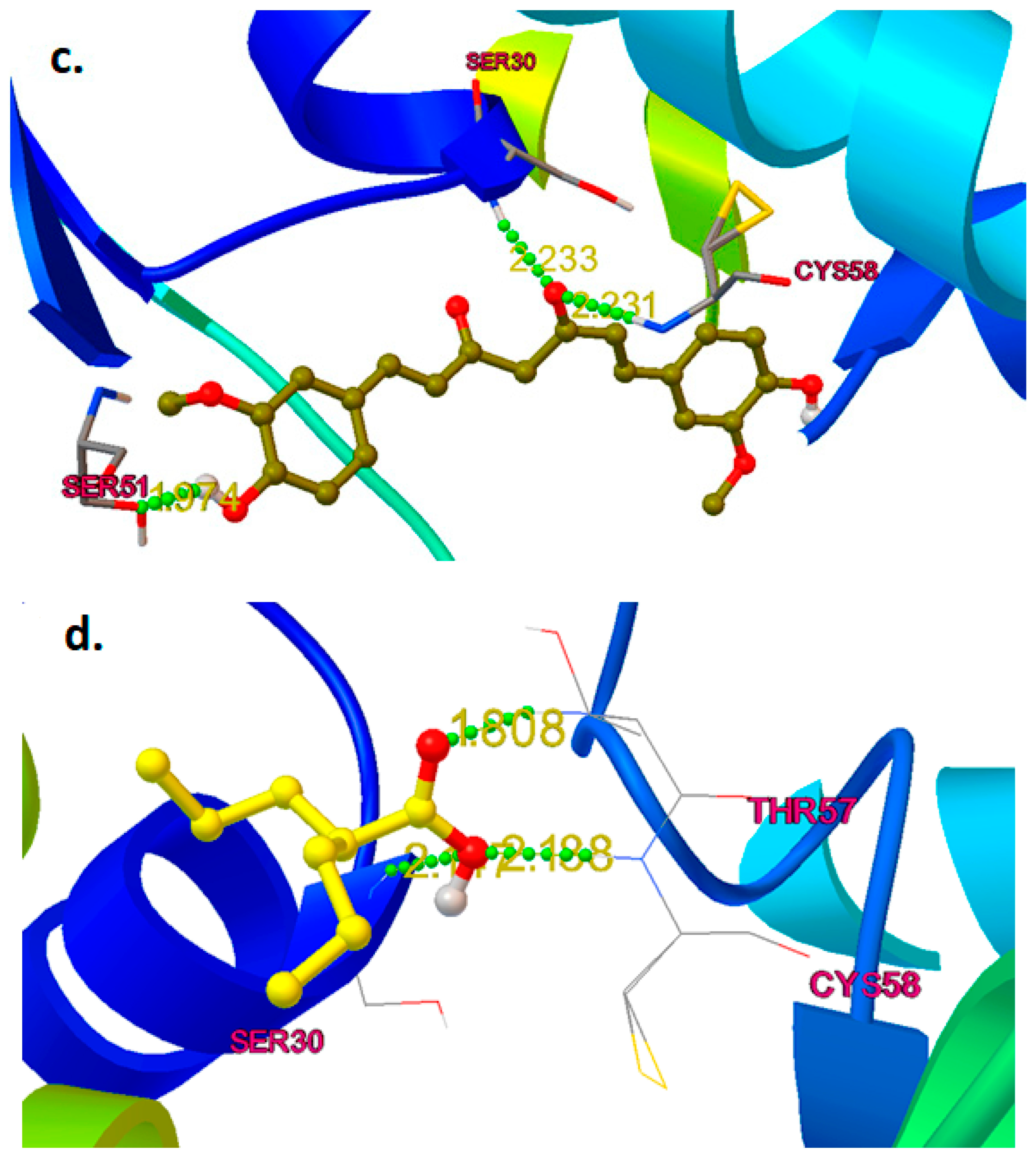

| Molecule | KI Value | Docking Score (Kcl/mol) | Hydrogen Bond Interaction |
|---|---|---|---|
| Curcumin | 0.264 μM | −8.97 | SER 51, GLY 29, CYS 58 |
| Quercetin | 2.33 μM | −7.68 | GLU 50, SER 51, GLY 158 |
| Chlorogenic acid | 3.29 μM | −7.48 | GLY 31, THR 57, SER 51 |
| Valproic Acid | 190.91 μM | −5.07 | SER 30, THR 57, CYS 58 |
| Groups (n = 6) | Treatments |
|---|---|
| I | Normal control with vehicle |
| II | PTZ (40 mg/kg, i.p.) was administered on alternate day for a period of 29 days |
| III | PTZ (40 mg/kg, i.p.) + MOEE (250 mg/kg, p.o.)—for a period of 29 days and 30 min. before PTZ treatment. |
| IV | PTZ (40 mg/kg, i.p.) + MOEE (500 mg/kg, p.o.)—for a period of 29 days and 30 min. before PTZ treatment. |
| V | PTZ (40 mg/kg, i.p.) + Curcumin (200 mg/kg, p.o.)—for a period of 29 days and 30 min. before PTZ treatment. |
| VI | PTZ (40 mg/kg, i.p.) + Curcumin (300 mg/kg, p.o.)—for a period of 29 days and 30 min. before PTZ treatment |
| VII | PTZ (40 mg/kg, i.p.) + Curcumin (200 mg/kg, p.o.) + MOEE (250 mg/kg, p.o)—for a period of 29 days and 30 min. before PTZ treatment. |
| VIII | PTZ (40 mg/kg, i.p.) + Valproic acid (100 mg/kg, i.p.)—for a period of 29 days and 30 min. before PTZ treatment. |
| XI | MOEE (500 mg/kg, p.o.) per se—for a period of 29 days |
| X | Curcumin (300 mg/kg, p.o.) per se—given daily by oral route for a period of 29 days |
Disclaimer/Publisher’s Note: The statements, opinions and data contained in all publications are solely those of the individual author(s) and contributor(s) and not of MDPI and/or the editor(s). MDPI and/or the editor(s) disclaim responsibility for any injury to people or property resulting from any ideas, methods, instructions or products referred to in the content. |
© 2023 by the authors. Licensee MDPI, Basel, Switzerland. This article is an open access article distributed under the terms and conditions of the Creative Commons Attribution (CC BY) license (https://creativecommons.org/licenses/by/4.0/).
Share and Cite
Alam, M.N.; Singh, L.; Khan, N.A.; Asiri, Y.I.; Hassan, M.Z.; Afzal, O.; Altamimi, A.S.A.; Hussain, M.S. Ameliorative Effect of Ethanolic Extract of Moringa oleifera Leaves in Combination with Curcumin against PTZ-Induced Kindled Epilepsy in Rats: In Vivo and In Silico. Pharmaceuticals 2023, 16, 1223. https://doi.org/10.3390/ph16091223
Alam MN, Singh L, Khan NA, Asiri YI, Hassan MZ, Afzal O, Altamimi ASA, Hussain MS. Ameliorative Effect of Ethanolic Extract of Moringa oleifera Leaves in Combination with Curcumin against PTZ-Induced Kindled Epilepsy in Rats: In Vivo and In Silico. Pharmaceuticals. 2023; 16(9):1223. https://doi.org/10.3390/ph16091223
Chicago/Turabian StyleAlam, Md. Niyaz, Lubhan Singh, Najam Ali Khan, Yahya I. Asiri, Mohd. Zaheen Hassan, Obaid Afzal, Abdulmalik Saleh Alfawaz Altamimi, and Md. Sarfaraj Hussain. 2023. "Ameliorative Effect of Ethanolic Extract of Moringa oleifera Leaves in Combination with Curcumin against PTZ-Induced Kindled Epilepsy in Rats: In Vivo and In Silico" Pharmaceuticals 16, no. 9: 1223. https://doi.org/10.3390/ph16091223
APA StyleAlam, M. N., Singh, L., Khan, N. A., Asiri, Y. I., Hassan, M. Z., Afzal, O., Altamimi, A. S. A., & Hussain, M. S. (2023). Ameliorative Effect of Ethanolic Extract of Moringa oleifera Leaves in Combination with Curcumin against PTZ-Induced Kindled Epilepsy in Rats: In Vivo and In Silico. Pharmaceuticals, 16(9), 1223. https://doi.org/10.3390/ph16091223







